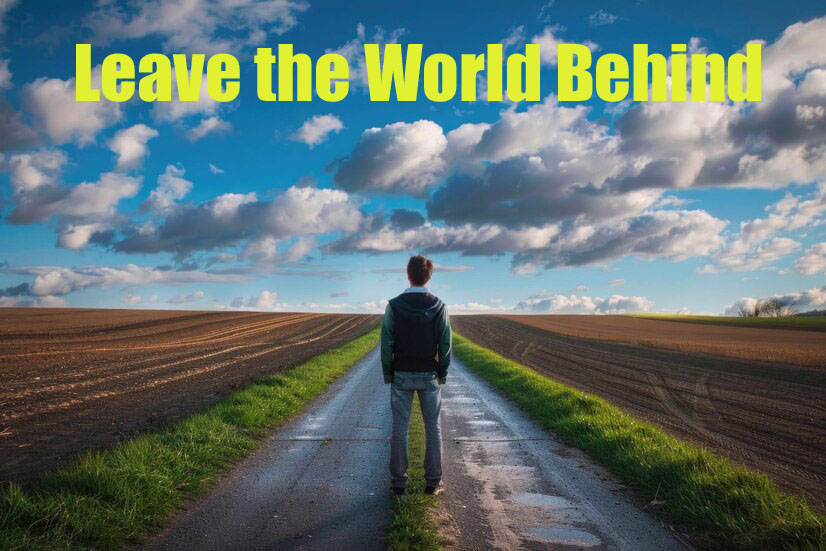Introduction
“Leave the World Behind,” a gripping novel by Rumaan Alam, has captivated readers with its intense portrayal of a vacation gone awry. This thought-provoking story delves into themes of isolation, fear, and human connection against the backdrop of an unsettling crisis. In this article, we will explore the key elements that make “Leave the World Behind” a compelling read, analyzing its themes, characters, and the unique way it reflects contemporary anxieties.
Synopsis of “Leave the World Behind”
Plot Overview
Amanda and Clay, a middle-class white couple from Brooklyn, decide to take a much-needed vacation with their two teenage children in a luxurious and remote Long Island rental home. Their idyllic getaway is disrupted when Ruth and G.H., an older Black couple who claim to be the homeowners, arrive unexpectedly, seeking refuge from a widespread blackout in New York City. As communication with the outside world becomes increasingly difficult, the two families must navigate their fears, prejudices, and the mysterious events unfolding around them.
Setting and Atmosphere
The novel’s setting—a secluded, upscale home surrounded by nature—creates a sense of isolation that heightens the tension. The claustrophobic atmosphere and the unknown threat contribute to the characters’ growing anxiety, making the reader feel the weight of their uncertainty and fear.
Themes Explored in the Novel
1. Isolation and Fear
“Leave the World Behind” masterfully explores the theme of isolation, both physical and psychological. The characters are cut off from the outside world, which exacerbates their fear and paranoia. This isolation serves as a catalyst for examining deeper anxieties about safety, survival, and the unknown.
2. Racial and Social Tensions
The arrival of Ruth and G.H. introduces a layer of racial and social tension. The interactions between the two families highlight underlying prejudices and the complexities of trust and power dynamics. Alam uses these tensions to provoke thought about societal divisions and the ways they manifest in times of crisis.
3. Human Connection and Empathy
Despite the initial mistrust, the novel also delves into the potential for human connection and empathy. As the characters are forced to rely on each other, moments of understanding and compassion emerge, suggesting that crisis can bring out both the best and worst in people.
4. The Fragility of Modern Life
The sudden disruption of the characters’ comfortable lives serves as a stark reminder of the fragility of modern conveniences and the thin veneer of security they provide. Alam’s portrayal of a world on the brink of collapse resonates with contemporary concerns about technological dependence and environmental instability.
Character Analysis
Amanda and Clay
Amanda and Clay represent the typical modern family, seeking solace in a temporary escape from their busy lives. Their journey from relaxation to panic mirrors the reader’s own fears of the unknown. Their reactions to the crisis reveal their vulnerabilities and the limits of their preparedness.
Ruth and G.H.
Ruth and G.H. bring a contrasting perspective to the story. Their calm demeanor and practical approach to the crisis initially clash with Amanda and Clay’s panic. Through their characters, Alam explores themes of resilience and the wisdom that comes with age and experience.
The Children
The teenage children, Archie and Rose, add another dimension to the narrative. Their youthful perspective and reactions to the unfolding events highlight generational differences in coping mechanisms and understanding of the world.
Literary Style and Narrative Technique
Narrative Voice
Alam’s use of a third-person omniscient narrator allows for a deep dive into the thoughts and emotions of all characters, providing a well-rounded view of their inner conflicts and motivations. This narrative style enhances the tension and keeps the reader engaged.
Pacing and Structure
The novel’s pacing shifts from a leisurely beginning to a rapidly escalating tension, mirroring the characters’ journey from tranquility to chaos. The structure, with its short chapters and frequent shifts in perspective, keeps the reader on edge and propels the story forward.
Critical Reception
Praise and Criticism
“Leave the World Behind” has received widespread acclaim for its timely themes and compelling storytelling. Critics have praised Alam’s ability to capture contemporary anxieties and his nuanced portrayal of complex social issues. Some, however, have noted that the novel’s ambiguous ending may leave readers craving more resolution.
Awards and Recognition
The novel has been shortlisted for several literary awards and has been lauded by prominent publications, further cementing its status as a significant work of fiction in recent years.
Adaptation and Cultural Impact
Film Adaptation
“Leave the World Behind” is set to be adapted into a film, with notable actors and filmmakers attached to the project. This adaptation is eagerly anticipated and expected to bring the novel’s gripping narrative to a wider audience.
Cultural Relevance
The novel’s exploration of themes like isolation, fear, and human connection has struck a chord with readers, especially in the context of recent global events. Its cultural relevance and timely commentary make it a significant piece of literature that resonates with contemporary audiences.
Conclusion
“Leave the World Behind” is a powerful and thought-provoking novel that explores deep-seated fears and the complexities of human relationships in times of crisis. Through its rich characters, tense atmosphere, and timely themes, Rumaan Alam has crafted a story that leaves a lasting impact. Whether you are drawn to its social commentary, its portrayal of human resilience, or its suspenseful narrative, “Leave the World Behind” is a novel that invites reflection and discussion.
FAQs
1. What is the main theme of “Leave the World Behind”?
The main theme of the novel is the exploration of isolation and fear, along with the complexities of human connection in times of crisis.
2. How does the novel address racial and social tensions?
The novel highlights racial and social tensions through the interactions between the two families, revealing underlying prejudices and power dynamics.
3. What is the significance of the novel’s setting?
The secluded, upscale home in Long Island serves to heighten the sense of isolation and tension, reflecting the characters’ psychological states.
4. Why is the novel’s ending considered ambiguous?
The ending leaves several questions unanswered, reflecting the uncertainty and open-ended nature of the crisis faced by the characters.












1 thought on “Leave the World Behind: The Themes of Isolation and Connection”